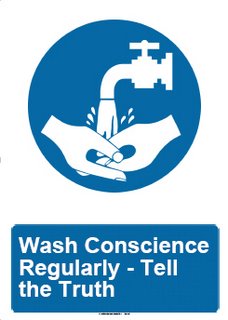 You may enjoy this site at which you can create official-looking regulatory signs with your own messages at Online Signs. No log-in required. I saw this posted at Ready Made and thought it was worth passing along.
You may enjoy this site at which you can create official-looking regulatory signs with your own messages at Online Signs. No log-in required. I saw this posted at Ready Made and thought it was worth passing along.
 You may enjoy this site at which you can create official-looking regulatory signs with your own messages at Online Signs. No log-in required. I saw this posted at Ready Made and thought it was worth passing along.
You may enjoy this site at which you can create official-looking regulatory signs with your own messages at Online Signs. No log-in required. I saw this posted at Ready Made and thought it was worth passing along.
There was a great blog entry by Michael Bungay Stanier, a Canadian coach and author, that reminded me of this today. The point he was making is that we can actually be more powerful and more capable than we are by employing some techniques of acting more capable and powerful than we feel. He had some excellent ideas and techniques to employ.
So, with the Pretender and Stanier's techniques in mind, here is a little experiment for you to run in your own life or career. I am very interested to know how it turns out.
1. Decide on a character that demonstrates the kind of vibe that you'd like to embody. It could be a historical figure or a fictional character. It should be someone that enough has been written about or that you can learn about to get to know their style and "observe" their behaviors.
2. Write down three things you like about this character that you'd like to embody. Post these prominently in your home or office. Remember you don't have to emulate everything about this person, just those characteristics you like.
3. Take the time to notice some physical thing that this character does/did that embodies an admired characteristic. For instance, if you like Jarod's intensity, note how he looked people in the eye and didn't say much. If you admire, Buzz Lightyear's bravo, notice how he stands up straight and speaks in a definitive tone. How does the person stand, sit, talk, work, organize their thoughts, learn new things, ask for help, work a room, etc?
4. Next time you are in a situation where you want to embody those admired characteristic, think about your character and emulate the physical action or attitude you observed and see what happens.
Remember, this is all within the boundaries of good ethics, honesty, and respect for others. If you are not qualified/trained/certified, don't offer to perform brain surgery or to do electrical work, please.
By changing your behavior, your language, your posture, and most of all, your attitude, can you change your circumstances? That is the question. If we have any influence over our circumstances, I would say "yes." The key is then deciding who you want to be and realizing that you don't have to wait to act like the person you admire
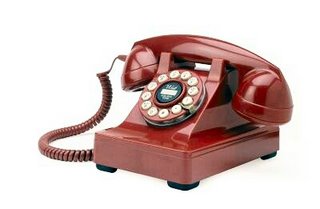 I used to think I was the only one with this problem, but during a recently conversation with some friends, I found out I am not alone. This has prompted me to confess: I hate voice mail. In fact, I really don't like talking on the phone at all. There I have said it. I am email person.
I used to think I was the only one with this problem, but during a recently conversation with some friends, I found out I am not alone. This has prompted me to confess: I hate voice mail. In fact, I really don't like talking on the phone at all. There I have said it. I am email person.Blame it on working for a software company early in my career (in my formative professional years) or because I always feel like I am interupting something when I call people. In any case, I would much rather exchange email then play phone mail tag. I would much rather drop someone a note, then give them a call and risk them not being home, not being available to chat, in short wasting their time (or mine).
Once I sat across from a colleague who was also an emailer. Even though we worked only a few yards from each other, we found that it was often more convenient to email. It allowed us to communicate asynchronistically (like when one of us was in a meeting), allowed us to copy others into the thread that weren't within earshot of our actual conversations, and allows us to include references like links and graphics that would have been hard in a face-to-face conversation.
So, I heard something advertised today that just might be the perfect tool for someone like me. It is calld Simulscribe and it converts your voice mail messages to text messages and emails them to you (or SMS to your cell phone, if you callers doing ramble). Has anyone used this or other tools of this sort? I am wondering how long it will be before one of the "phone companys" that are also into hand-held or data services offer a phone plan that isn't a phone plan at all: it is just voice-to-text message services.
Now, I understand that many of my close friends are phone people. I like them. I admire their commitment to building relationships, resolving conflict, and reaching out. I know that email isn't an appropriate medium for lots of messages (ie, "we should start seeing other people," "You're Fired," and "the lump looks suspicious" come to mind), but for 90% of things you want to say, email works fantastic!
There are whole industries that have not recognized or served people like me. The medical profession for one. I can not go online to book an appointment with my doctor or dentist. They don't confirm or reschedule via email. They won't answer routine questions via email. The same for the hair salon. As if it wasn't inconvenient enough to go to these places, they make it even more so by not letting "non-phone" people make appointments or find out your stylist's hair gel recommendation. I hope some of these folks are reading and can see that they have an underserved population (that is growing, I suspect) that could be effectively targeted with a few services that don't rely on the phone.
If they can figure that out, perhaps someone can also invent a dynamic voice mail recordings that connect to your Outlook calendar to provide daily personalization to your message: "Hello, you have reached Jennifer Davis. It is Monday, August 30th and I am in the office..." It always bugged me that I had to enter conflicts on my calendar and then record a duplicate message on my phone. But then again, I am not a phone person.
"About ten years ago, while a manager for Washington State, I took a week's class from a person considered, at the time, maybe the most talented and accomplished person in Washington State government, Dick Thomas. He'd been Chief of Staff for the Governor, house majority leader, president of Evergreen State College, etc., and a very cool guy to boot. When I took that class, he said two things over and over.
Long after the class ended, I finally began to understand the wisdom of these two simple thoughts:
1. Policy is what happens.
2. Peoples' feelings about the process largely determine their feelings about the outcome of the process."
Sometimes we can fool ourselves into thinking that great policy is synonymous with a deliberate culture or that documented processes lead to good results. My experience echoes that above: good people doing good things leads to good results. If the results are measured and celebrated, the culture adjusts to reinforce the behaviors that lead to the good results. Sometimes by the time you have processes and policies documented, the business environment has changed and the good people on your staff have made the necessary adjustments. Then, the documentation, coordination, and training begins again. The official action of policies and processes follows the intention and the engagement. Not the other way around.
Design-Her Gals lets you customize the look of a "paper doll" choosing your body type, hair style, coloring, outfit and accessories. Then, you can print your likeness on a variety of stationary items, stickers, t-shirts, etc. A portion of the proceeds goings toward stage 4 cancer patients. It was fun to play, if nothing else.

If you aren't a "gal" or if sketches aren't your style, you can always try the Mini-Mizer and picture yourself as a plastic lego character. The link to the kid-safe version (you can only imagine what the alternatives might be).

 I ran across an ad for a beautiful product tonight and I couldn't resist playing with their interactive website. Takohl makes rings that hinge open to reveal custom messages or gemstone settings.
I ran across an ad for a beautiful product tonight and I couldn't resist playing with their interactive website. Takohl makes rings that hinge open to reveal custom messages or gemstone settings.They are beautiful designs (at least from the pictures) and fit that category of products that I love: mass customized! Jewelry is a natural for this kind of production, because of the "crafted" nature of the products. However, you don't see a lot of mass customization options, despite the growing number of online retailers (ie, BlueNile, The Pearl Outlet, etc). The only example I could think of, besides truly custom boutique shops, was John Christian (the guy who advertises in the airline magazines). This seems to be a great opportunity for differentiation.
I wonder what other product categories could benefit from a mass customization approach. Fine art, perhaps? Check out Little Masters by Rebecca Hull for an example of this. Clothing design? Fabric or wallpaper patterns?
And, who can forget the NikeID program for customized sneakers and watches or custom-printed M&Ms just in time for holiday parties.
"Throw it away"
A common phrase basically describing a process by which unseen elves dispose of trash. No one thinks much about where it goes, but I think we are all aware that in fact "away" is not a place you can store trash. Eventually, it has to find a resting place in a landfill, a recycling center, or other location to be dealt with. The growing population centers, increases in packaged good consumption, and very present global economy make "away" closer to home. This leads to the ever dreaded "landfill in my backyard." So, it seems that the term "throw it away" is a myth.
"Get away from it all"
A phrase used to describe a tropical vacation or a roadtrip. In either case, getting away from one thing, just means going somewhere else. If the escape isn't physical (but rather found in the pages of good literature or a dip in a bubble bath), then the separation between "away" and "here" is just one of attitude. So, it would seem that "getting away from it all" is a myth.
"In a land far, far away..."
This fairy tale opener got top billing as Fiona's hometown in Shrek 2 (itself a piece of fiction). I guess this phrase which imparts a distance in both geography ("far, far away") and time ("once upon a time") is meant to imply that the story being told is one of adventure and romance. Somthing far removed from the mundane and routine lives that are lived in this time, in this place. So, "far, far away" is a mythical place.
As I have been thinking about this, I am amazed how frequently we use the word "away" when in fact it has no meaning at all. It is an "out of sight, out of mind" place where inconvient, dirty, or bothersome things can be sent without any thought to the ramifications. However, as we consider our world and our society, it is clear that if "away" wasn't already mythical, it would at least be going extinct.
So I suppose the admonition to "Go Away," could just as well be "Go live happily ever after...somewhere else!"
It is a blessing to have a team that is capable, smart, informed, effective, and accomplished. It is a greater blessing to have a team that is capable, smart, informed, effective, and accomplished, who will tell you when you are not and what you can do about it.
The same applies to personal friendship on many levels. You have to care enough to tell a friend that their spinach salad is ruining their smile. You have to care deeply to take a friend aside to ask about her marriage, his children's behavior, or a concern you may have about a financial decision they are considering.
An accomplished leader for whom I work told me recently that the secret to not "running a business into the ground" is to assemble the best team possible and build a culture where they are not afriad to tell you that you are full of it. I would add that two more things are required to make that work. First of all, you have to leave your ego at the door, which enables the culture where differing opinions from yours are valued and employees with ideas or concerns feel safe to air them. The second thing that is required: your team also has to care. If honest feedback from capable people (the right "people on the bus," as Jim Collins put it) creates the business performance you want, then the job of the leader is to inspire trust and commitment to the extent that people will overcome the natural tendencies to say "yes," and will tackle the hard and tedious task of saying "no."
I hope that I have colleagues in my professional life and friends in my personal life that will tell me the honest, sincere truth...even if I don't want to hear it. I hope I always want to hear it.
 I recently heard a speaker from FranklinCovey at MOPS talk about the importance of distinguishing between what is "important" and what is "urgent." Seth Godin just published a little article along the same topic saying that most of things we do that we consider important and urgent, are actually neither and can't even be recalled after the fact.
I recently heard a speaker from FranklinCovey at MOPS talk about the importance of distinguishing between what is "important" and what is "urgent." Seth Godin just published a little article along the same topic saying that most of things we do that we consider important and urgent, are actually neither and can't even be recalled after the fact.These caused me to reflect on some advice my grandmother has given her children and grandchildren on many occassions: opt for the memory. She says that in her 85+ years, the things that she remembers are the most precious. So, when you have an opportunity to do something that represents an adventure, a challenge, a chance to build a relationship, etc, always opt for that option which will produce a positive memory. A memory that will bring joy to other moments in your life.
The natural extension of this is taking the opportunity to build positive memories for others. After all, life's choices do not just leave their impression on us. They leave a lasting impression on others as well. What a powerful truth to harness!
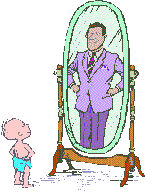 I heard someone editorialize this week that no one is capable to act inconsistent with their perception of themselves for a prolonged period of time. Apparently, this author's well-researched view was that you can not sustain something that is internally consistent with what you think you are about, what your capable of, or what you believe your choices to be. The speaker said it in a way that made me think that these perceptions were "fixed" and although they could be influenced, they could never be substantially changed.
I heard someone editorialize this week that no one is capable to act inconsistent with their perception of themselves for a prolonged period of time. Apparently, this author's well-researched view was that you can not sustain something that is internally consistent with what you think you are about, what your capable of, or what you believe your choices to be. The speaker said it in a way that made me think that these perceptions were "fixed" and although they could be influenced, they could never be substantially changed.In some ways, this may be true. You certainly see a lot of example of this in real life. People believing themselves to be incapable and then proving themselves to be incapable, time and time again. A vicious cycle to be sure. One of the best interviewing techniques I have used is one that looks for patterns of performance and work style, even as they were demonstrated in childhood or early in the prospect's career...at positions that are all, but irrelevant to the position for which the interview is being conducted. Human Resources research and the Effective Interviewing techniques, have shown that past behavior is the only consistent indicator of future performance. High achievers with good work patterns will continue to achieve.
Yet, I don't want to believe it is true. I want to think people can reinvent themselves, with sheer will or good mentoring, to act differently and then be different. This is the foundation of discipleship. This is the foundation of education, isn't it? That a person can better themselves, see demonstration of improvement, be encouraged to further better themselves. I want to think that a Harry Higgins could take a scruffy-faced and sour-tongued Eliza Doolittle and pass her off as a dutchess at a society ball and help her transform herself into a larger version of her previous self. A virtuous cycle.
Is is possible? How does one kick-start a transformation to overcome the inertia of damaging (or at best, useless) self-perceptions?
Picture from Lynn Meade.
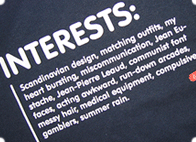 So, there are blog posts going around right now that ask people to document their favorite and least favorite books. Read my list here. It is interesting to read these posts from friends and colleagues. Very insightful, I think, to know the books that influence us the most.
So, there are blog posts going around right now that ask people to document their favorite and least favorite books. Read my list here. It is interesting to read these posts from friends and colleagues. Very insightful, I think, to know the books that influence us the most.Then, I saw this...you can list your top 5 favorite interests, books, artists, albums, bands, or whatever on a customized t-shirt, via a site called t-list. I thought it was a natural extension of the mass customization that is really sweeping the web and inspiring people to express themselves in the products that they buy and wear in new ways.
If you order a shirt, post your selections here!
 So, I saw this do-it-yourself automotive head's up display and it made me smile. For those of you who haven't kept up on these things, having a display embedded or projected onto a windsheild of a car has been talked about for decades. This low-tech approach is not perfect for all conditions of course. It works great if dynamic data wasn't required and the lighting conditions are right. Even with these limitations, it does remind me that often we overthink solutions when a workable and cheap idea is right in front of us!
So, I saw this do-it-yourself automotive head's up display and it made me smile. For those of you who haven't kept up on these things, having a display embedded or projected onto a windsheild of a car has been talked about for decades. This low-tech approach is not perfect for all conditions of course. It works great if dynamic data wasn't required and the lighting conditions are right. Even with these limitations, it does remind me that often we overthink solutions when a workable and cheap idea is right in front of us!Reminds me of the story (perhaps urban myth) that NASA spent millions of dollars developing an ink pen that would write in the zero-gravity conditions of space, all the while believing themselves to be clever and technologically-advanced. Meanwhile, on the other side of the globe, Russian cosmonauts were just using pencils. Whether it is true or not, it is a good reminder that technology should be relevant and add real value.
So, while the folks at the car companies figure out how to put more electronics into our dashboards, I might just print my maps out in reverse next time and try this approach.
Actually, makes me wonder what other sites could be started up in this fashion. Perhaps some of these are real, but here are my ideas:
[name].isajerk.com
[name].iscool.com
[name].isthesmartestpersonIknow.com
[name].blowsmymind.com
[name].hasagreatproduct.com
[name].takesgreatpictures.com
[name].makesmusic.com
[name].isgrateful.com
[name].lovesgardening.com
[name].lovesU2.com
Now, some of these could have more features than a "certificate," perhaps even getting into syndicated web content. The "lovesU2.com" could be linked in to a band fan club or the like. Sounds like a new business opportunity. Anyone? Anyone?
P.S. I learned about this one from Andy Wibbels who is andy.isreallyawesome.com, apparently.
The Personal MBA is a online community that is reading 33 business books on a variety of interesing topics. I can personally recommend many of the titles and others on my"to read" list. Look at the manifesto for more details.
So, here is a thought. Get a group together at your work. Get your employer to pay for the books and some meals for the group meetings (this would be A LOT cheaper than tuition reimbursement for a real MBA program) and shared your own business school. Classmates could write papers for each other to critique. They could devise their own presentation assignments and reference hand-outs. Doing two books at month (and two meetings to discuss them and present out would take just a little over a year, if you went straight through. I think this could be a lot of fun and a very practical way to broaden the thinking and improve the business acumen of an entire group. You could even print certificates at the end!
If you do this, you can go ahead and call it the "Davis School of Business" if you want.
Writing books are all the craze now-a-days. I've heard that 75,000 books are published each year and it is easier than ever to do it yourself. There are now a host of companies that will allow you to self-publish and print on demand. Some popular ones include Xlibris (owned by Random House), BookSurge, cafepress, or iUniverse. To read on how to approach a project like this, see Seth Godin's Advice to Authors.
I have a friend, Jerry Dawson, who a few year's back published his own book, Sales 101: Princples in Action. I recently asked him about the process and I thought I would share his insights here.
What made you want to write a book?
My sales experiences were varied enough and I thought what I had learned was worth sharing.
How did you go about writing and publishing the book?
The self-publishing process is the same as going through a traditional publisher, except I had total control over the content, length, and organization of the book. I worked with BookSurge, which was purchased by Amazon, which provided great exposure for the book right out of the gate. That said, it is left to me to market ths book. I have been marketing the book mostly by giving copies to friends and associates. The response to the book has been very positive. I spent under $1,000 to publish the book and get the first 100 copies. Although I have yet to turn a profit, the book is selling.
What was the most surprising thing about the process?
Just how hard it was to write the book. I spent over two years collecting my thoughts and writing up small snippets and then hours and hours of editing and re-writing to complete the book.
What advice would you have for other would-be authors?
Only to focus completely on what you are writing about – get a good editor so you don’t waste words – solicit the opinions of others when appropriate – keep it simple.
One of these days I will write and publish a book or two. For now, the ideas go into folders and I blog on. If you are like me, but don't want to wait, you might check out Andy Wibbel's program entitled "Write a Book in 45 Days and Other Ways to Blow Your Own Mind." As he so aptly put it: "shut up and write" and sometimes a little structure is what we need to get us going.
So, that is my advice to would-be-authors. Start already!
Traditional brainstorming doesn't work. Why?
- Traditional brainstorming doesn't generated that many ideas. Luke'sexperience is that the well runs dry in about 20 minutes. We've all experienced that uncomfortable moment when the room goes silent.
- The ideas aren't really that novel. Yeah, a few weird ones emerge,but overall low quality.
- Only a fraction of the ideas generated get used. Not an efficientuse of time and creative energy.
So, what's his technique?
- STEP 1: Decide on a focus area. Define the problem you're trying solve or product you're trying to develop. In our workshop he told us to think of an educational handheld product for preteens.
- STEP 2: Break up into groups of 2 to 4 people. Small groups generate more, and more novel, ideas than big groups.
- STEP 3: Assign each group a different random word (a noun) to generate associations. Use a dictionary. Pick of a page number, column numberand the number of a word in that column. Go there. If it's not a noun, read down until you reach the first noun. Our word was WHEAT.
- STEP 4: Have everyone individually start writing down their assocations with the random word. Mine were BAKING, WAVING, FLOWING, SEED, STALK, BREAD, HEALTHY, GROWING, ORGANIC, MACHINERY, FARMING, OUTDOORS, FIELD, BIG, EXPANSIVE, SUNNY, HARVEST, etc, etc. Do this for about 5 minutes. Then, share your associations with the group.
- STEP 5: Use these associations to generate fresh ideas about the focusarea for 10 to 15 minutes. Do this as an individual at first. Write each idea down on a post-it note. For example...SUNNY --> Solar powered unit that teaches kids about light, photons,etc.HEALTHY, ORGANIC, BAKING --> Product that teaches kids about nutrition.You can stick a sensor into food and it does basic analysis, e.g.,sugar content. Or you can enter in what you're eating and it will tellyou all about it....
- STEP 6: Have everyone present their ideas to the group and let newideas emerge as part of the discussion. Write these new ideas on apost-it note.
- STEP 7: Select another word or find a random object (he gave use a black desk stapler) and repeat steps 3 - 6. Generate new associationsand use them to generate more ideas. You'll be amazed how many novelideas emerge in round 2!
- STEP 8: Have each group present to everyone their random words/objects,the associations and product ideas that resulted. Write down any newideas generated by discussion on a post-it note.
- STEP 9: Place all the ideas into one of four categories
1. Specific Idea - Well formulated idea that offers immediate value.
2. Beginning Idea - Good potential that needs to be developed
3. Concept - General way of doing things
4. Approach - Very broad, general direction.
- STEP 10: Turn 'Approaches into 'Guiding Principles' that can be usedover and over.
- STEP 11: Turn 'Concepts' and 'Beginning Idea' into 'Specific Ideas' bylisting what would have to be done to make them more useful. Forexample, what technology obstacle would have to be overcome to make anidea practical.
- STEP 12: Rank all the 'Specific Ideas' through some voting process and start implementing!
I can't wait to use this technique. Try it and let me know how it works. Better yet, we could try it here if someone could suggest a problem to solve.
This made me realize that perhaps there was a technology that I needed, that I had previously considered "technology for its own sake." Specifically, the internet-enabled washing machine and dryer.
Apparently Whirlpool has teamed with Panasonic and Microsoft to create a washing machine that can send text messages or emails. Perhaps if I had gotten a reminder email, I might have salvaged this load. How does one get to be a beta tester for these kinds of technologies?
Now, if I can only send an email to have clothes gathered, sorted, and a load ran and dried. I guess I'll just have to keep hoping for a maid with a Blackberry.
Turn yourself into a comic book:
Artist Lina Chen turns your photo into a black and white drawing at www.Digi-Portaits.com. The before image on the left becomes the illustration on the right for around $100.
iPodMyPhoto turns your photo into the iconic black sillouette against a bright background found on those great iPod advertisements for $19.95 an image. You can choose your background color and whether or not the subject is wearing a white iPod.
Remove tourists from your vacation photos:
This creative service from SnapMedia allows you to load a series of photos of the same subject and they combine them into one image with all the strangers removed that might have obstructed your view.
So, that (and a recent invitation for a custom fitting of Carlisle clothes in a woman's home) got me thinking what product demos I would invite into my home, or even pay to host. This is how the Experience Economy (see previous post) could be implemented through Tryvertising. Here is my list. What others would you add?
- Foot Spa Escape: invite a bunch of girl friends over for a foot spa with Body Shop or other products (I have, in fact, hosted this party). Could also work for "makeover" parties, manicure parties, "shaping your eyebrows" parties, or any type of beauty party.
- Garden Party: invite friends over to learn how to create a hanging basket with a representative from Michigan Bulb, Monrovia, or Jackson & Perkins.
- Music Burning Jam Session: listen to tunes and burn your own CD of songs from new artists.
- Digital Photography Workshop: Play with cool cameras (from Sony, Nikon, or Kodak) and take pictures of children or friends in a photo studio set-up with different backgrounds and props on-hand. Afterwards the pictures could be posted to Flickr or Evite, if they got in on the party.
- Scarf Party: Use RIT dye to create one-of-a-kind clothing art.
- Garden Globe Workshop: create a garden globe or other yard art using Black & Decker tools, 3M adhesive products, or other supplies.
- Easter Egg To-Dye-For: bring your own eggs to a dyeing event showing all the latest techniques.
I can think of a lot of "consumer" products that could create an experience around them. Even in the B2B space, I could think of a number of things that would be popular and help vendors sell more products. Here are a few ideas:
- Cool Office Supply Demo Day: the latest and greatest products from Mead, Bic, 3M, and other brands come together to let people try them out. Free samples lead to addiction and purchases.
- On-site Eye Exams: A lot of employers offer reimbursement for eye-glasses or contacts, but a lot of people don't take advantage of the benefit. Why not invite an eyeglass company and optomitrist into the office to give free exams and take orders for glasses?
- Chair Massage: A free chair massage could advertise a local massage salon, spa products, candles, or soothing music (or all of the above).
What company/product do you wish you could get a demo party for in your home or office?
Technology has enabled methods of production that are new. Digital content products (like the iStockPhoto example) are naturals for this, but imagine it applied to other products.
Digital printing is enabling the same sort of business model for a variety of printed items. You no longer have to rely on Hallmark to create the perfect card. You can order your own custom designed postcard and have the post office mail it for you (www.premiumpostcard.com). You don't have to rely on Old Navy to create a t-shirt for you, you can go out to www.threadless.com and buy one that your friend (or a clever stranger) designed. You don't have to rely on Uncle Sam to design a commemorative postage stamp, you can create your own at Zazzle. Furthermore, on many sites (including the last two I mentioned) you can leave designs for others to buy and make a commission for all sales. You don't have to wait for Random House to give you an advance for your mystery novel. You can publish it yourself through www.booksurge.com or www.xlibris.com and see it on Amazon tomorrow, with orders fulfilled through print-on-demand without inventory. All of this makes me wish I could draw or had the time to write!
I really liked the Procter and Gamble experiment called reflect.com that used to let you design your own cosmetics. I think it was just ahead of its time when they shut it down. With a new web 2.0 business model applied, this could have been a way for individuals to create their own branded line of cosmetics and resell them on their blog, in their self-published beauty book, or to their own friends and family through a custom designed mailer printed at PSPrint. Modern technology allows the emphasis to be on brand building, not product building.
So, what about other products that are relatively easy to produce consistently, have a high creative content, and can be easily distributed? I could see whole cottage industries being enabled by this technology.
Online jewelry sites where individual artists pool their talents or take custom orders. Online copy editing services where people post copy and pay a fee and professional editors give critique and get paid by the read. What if you could get your MRI read by a group of radiology students, in addition to your radiologist. You could help fund someone's residency while getting a valuable second opinion. You don't have to wait for a concert promoter to bring your favorite artist to town. You could book an act, rent a venue, and sell your own tickets using www.MollyGuard.com. Could these technologies be applied to give more economic opportunities to women and children in impoverished countries (who currently have to make unspeakable and unfathomable choices for survival)?
What other business ideas could be enabled in this way?
I read recently about a company in Business 2.0 magazine called Ocean Tomo that plans to broker intellectual property. You have invention and you give them a cut of the royalties if they find you a licensee. Like eBay for IP, perhaps. I wonder if they will take it as far as some of these other sites giving you the tools to do the patent filings, previous art searches, and the like? Man, I would love and use that, as would a lot of other people with great ideas, but without the time or resources to pursue monitizing them all. (Don't believe me? Check out my Invention Recycling site at www.inventionrecycling.blogspot.com).
Thanks, Todd, for getting my creative juices flowing!
 Here is a free, virtual white board, designed and hosted by a small little outfit call General Electric. It is taking the web by storm, causing waves of viral marketing, and probably not selling any jet engines. It is fun, though, and it makes me wonder where GE's ImaginationCubed is headed?
Here is a free, virtual white board, designed and hosted by a small little outfit call General Electric. It is taking the web by storm, causing waves of viral marketing, and probably not selling any jet engines. It is fun, though, and it makes me wonder where GE's ImaginationCubed is headed?Maybe even GE does things...just because they can.
Invite me to color with you if you want via email. And, feel free to send me a Wacom tablet if you actually want to be able to make sense of what I draw or write.
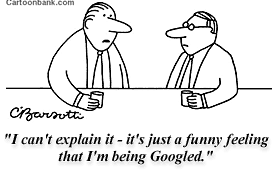
It is truly incredible what a professional public relations firm can do for you. I have worked with several in the past and the good ones can really make things happen. It is dream of mine someday to have my own publicist, but I suppose I should strive to be a bit more accomplished first (although that might be unnecessary if the publicist was good enough).
To the extent that you are your own publicist as well, I ran across a free press release distribution service today that might be of use to us. i-Newswire will distribute your news on a variety of news bureaus and the like for free (or you can pay, of course, for more and better services).
This site was featured in a strange news story about a 15 year old boy who wrote up a fake press release about being hired at Google ("the company's youngest employee ever" the press release reported). He did it as a joke and it was picked up by thousands of outlets and caused quite a stink. So, I figure if it will work for bad news, it might work for us, too!
When you are writing your release, keep in mind a fun technique that my friend Tamara Greenleaf used in a release for a Web conference whose headline boldly announced that "Steve Jobs will not be the keynote at this year's event." The completely true headline sent all the web spiders and Apple-afficianios into a tizzy and got them a lot of great publicity. Brilliant!
If these releases should teach us anything it is that we should pepper our news releases with key words that will broaden its appeal. You can test out some words by looking at search trends at Google Trends (look at me peppering this blog post with several mentions of Google...oops, I did it again!)
Some body please try this and let the rest of us know how it worked. In the meantime, I'll be working on doing something newsworthy!
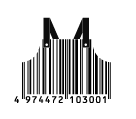 Saw this featured on Digg and thought you'd enjoy it. I love it when people see the mundane in new ways and take the opportunity to innovate! These guys at BarCode Revolution are onto something.
Saw this featured on Digg and thought you'd enjoy it. I love it when people see the mundane in new ways and take the opportunity to innovate! These guys at BarCode Revolution are onto something.
This falls into the "why didn't I think of that" category. What other necessary things (like barcodes) could be revamped if we looked at them differently?
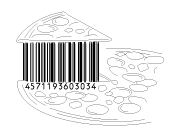
 I couldn't help but make a parallel between two news stories yesterday. One, Ken's fatal heart attack and the sabre-rattling missile launches of North Korea. I should say that I normally don't discuss politics and am not aware of all the subtleties of the issues at hand, but from what I do know North Koreans believe themselves to be the most technologically-advanced country in the world, with the most beloved and respected leaders. Truth is, that they are in the dark. Literally and figuratively. They live in poverty, without modern technologies and are feed government propaganda from morning until night. This aerial night photograph was shown on Good Morning America today and shows the stark contrast between North and South Korea. To believe that North Korea is an advanced country is not optimism, it is delusion.
I couldn't help but make a parallel between two news stories yesterday. One, Ken's fatal heart attack and the sabre-rattling missile launches of North Korea. I should say that I normally don't discuss politics and am not aware of all the subtleties of the issues at hand, but from what I do know North Koreans believe themselves to be the most technologically-advanced country in the world, with the most beloved and respected leaders. Truth is, that they are in the dark. Literally and figuratively. They live in poverty, without modern technologies and are feed government propaganda from morning until night. This aerial night photograph was shown on Good Morning America today and shows the stark contrast between North and South Korea. To believe that North Korea is an advanced country is not optimism, it is delusion.Although the comparison maybe unfair, I suspect that Ken Lay and North Korea are similar. Both of them were/are detached from reality. Both the people of North Korea and Ken Lay probably were buffered from brutal reality with misinformation, by well-meaning lieutenants who made sure the news was always good, and they were mislead by their own deep-seated desire to believe things were going well. Optimism is the belief that you can improve a situation when confronted with brutal facts and reality, not a disregard for those facts. It is a belief that there is some good that will come from every circumstance, not the creation of a fantasy world.
Let's not blame optimism for Ken Lay's disgraceful behavior. Optimism is innocent. Moreover, it was probably an optimistic attitude that helped Ken's weak and damaged heart keep pumping until after the criminal conviction when the truth finally caught up to him. I don't know what will pull North Korea from their delusions. I'll leave that to the politicians.
 "Almost all absurdity of conduct arises from the imitation of those whom we cannot resemble." - Samuel Johnson
"Almost all absurdity of conduct arises from the imitation of those whom we cannot resemble." - Samuel JohnsonI was reminded today of the importance of "sharpening the saw." This phrase was made cliche in Stephen Covey's The 7 Habits of Highly Effective People. But I connected with it in a different way today. I asked myself, "what saw do I sharpen?" and I thought in reply, "the one in hand."
Now, all of that may sound silly (especially the part where I talk to myself), but I am puzzled by how often we strive to sharpen a saw we don't have. In their books First, Break All the Rules and Now, Discover Your Strengths, authors Buckingham and Clifton propose that instead of trying to remediate areas of weakness, we should all rather focus on areas of strength and develop those. They claim that the return on investment in our strengths is staggering and could lead to world class performance. This is in contrast to remediation of weaknesses, which rarely makes anyone better than mediocre and saps time and energy away from developing our strengths (the opportunity costs of misplaced personal or professional development). Said another way, we should focus on becoming our best selves and not a sad imitation of someone else.
Their book includes a talent assessment of sorts which identifies five strengths worth developing further. This was an insightful exercise for me and a bit uncomfortable as well. Whether right or wrong, they listed my #1 competency as the ability to "woo" - which stood for "winning others over." This seems to be to be a powerful, and potentially dangerous, one. I have spent a lot of time thinking about this and implications of it. If this is really a strength, by sheer force of enthusiasm I might be able to convince people of something that is a bad idea or I might unwittingly limit discussion and dissent. I hate to think that I have ever limited the creativity of others or the wisdom of a team because I won others over to a flawed or incomplete idea. Using gifts of this sort wisely and always in the best interests of others is part of the sharpening that I'll be working on.
What talents do you see in yourself or in others that deserve additional sharpening? Do you have examples of sharpening the saw in your hand that have demonstrated (or disproved) this idea?
The key points of his session were as follows:
- There is a progression from commodities (the things that come from the ground), to goods (packaged items for convenience), to services (where someone else does the work for you), to experiences (where people pay admission and the goods are just the souvenirs or memorabilia).
- He proposes that "the experience is the marketing". He says that to build demand, you must stage marketing experience (think: Pike Place market in Seattle that throws fish to captivate shoppers)
- He suggests that people should "audition", not "interview" their front-line employees. They should train them like an actor to fulfill a role in the staged experience, and uniform them appropriately. (Think: GeekSquad or the "cast" at DisneyLand)
- Customization is the anecdote to commoditzation. He had many great examples of this. Is there a way to do mass customization or personalization experience to build loyalty and a premium brand? (Think: Build-a-Bear Workshop) The key here is not just customizing the product, but rather getting people to think of the experience as the product they are purchasing and the goods as the take-away from the experience: not the other way a round.
- Beyond experiences is transformations. This is really what educational institutions, healthclubs, coaches, and business consultants try to create. Can we help our customers transform themselves or their businesses by the experiences we stage?
Customization and personalized experiences are common themes in the sites and tools that I regularly use and talk about here. They are also evidenced in the growing industry of life coaches and consultants. Are there other companies that are doing this well? If so, I'd love to hear about them.
For more information on the author and the concepts, check out http://www.strategichorizons.com. Their book is filled with fantastic examples of this and is a provocative read.
I read an interview (with Men's Health, republished on the Innovation Network) with award-winning advertising agency, Weiden+Kennedy, which outlines their five rules of creativity. The ideas below echo the "yes, and" approach.
- Act Stupid. "Our philosophy is to come in ignorant every day. The idea of retaining ignorance is sort of counterintuitive, but it subverts a lot of [problems] that come from absolute mastery. If you think you know the answer better than somebody else does, you become closed to being fresh." states Jelly Helm, creative director.
- Shut up. "The first thing we do when we meet with clients is listen. We try to figure out what their problems are. Then we come back with questions, not solutions. We write these out and put them on the wall. And then we circle the ones that we think are interesting. More often than not, the questions hold the answer."
- Always say yes. "What I've learned from improvisation is to let go of outcome and just say 'yes' to what ever the situation is. If you say an idea is bad, you're creating conflict--you're breaking an improv rule. You want an energy flow that moves you forward, as opposed to a creative stasis."
- Chase Talent. "Find people who make you better. It's best to be the least talented person in the room. It's reciprocal. It challenges you to keep up."
- Be Fearless. "Do anything, say anything. In the worlds of our president, Dan Wieden, 'You're not useful to me until you've made three momentous mistakes.' He knows that if you try not to make mistakes, you miss out on the value of learning from them."
You should note, however, that there is an important difference between "yes, and" and always agreeing with your collegues or leadership. Although you can always find something to align around as a starting place (ie, the point of “Yes, And” and the basis of a host of effective communication tools), it is important to get conflicting views on the table.
In a recent Harvard Business Review interview, author Michael Roberto was asked about why it was essential for leaders to spark conflict in their organizations, as long as it is constructive. His book Why Great Leaders Don’t Take ‘Yes’ for Answer outlines why it is important for people to speak up and for others to listen. He compares and contrasts prevalent corporate cultures as follows:
- The Culture of No: Coined by Lou Gerstner to describe the situation he inherited at IBM in the early 1990s. It is a culture of indecision where dissenters have veto power in the decision and dialogue is stifled.
- The Culture of Maybe: An analytical approach, combined with a discomfort for ambiguity, leads to paralysis as the organization strives to be certain (see my previous post on certainty versus clarity).
- The Culture of Yes: Dissenters are encouraged to offer alternate explanations of the facts and respectfully challenge the status quo, with the idea that everyone is building towards something better together.

It is a sunny Summer afternoon in the middle of a long, holiday weekend and my mind drifts to the ridiculous.
Having just named a new baby, I know the stress associated with choosing the "perfect" name. The same stress faced in corporate conference rooms as marketeers chose relevant and protectable brand names. All of this brought to mind a few tools I have run across online to generate names. Below is a list of some of these. Enjoy!
- Brand Name Generator
- New Media Company Name Generator
(with free bonus taglines) - Random Human Name Generator
(great for professional services companies and newborns)
Now, for those of you that are naming pets or are in the pet food business, here is a cat name generator. There are others for Hobbit names, Jedi names, country music names, "pimp my name," pro-wrestler names, band names, pharmceutical product names, and others you can find on Google.
Once you have your name or brand, now you can use a whole other genre of useful webtools - see the advertising slogan generator or the Sloganizer.
Have a great holiday!
 This "Innovation Self-Diagnostic test" might be a good conversation starter about your company's ability to foster and capitalize on innovation initiatives.
This "Innovation Self-Diagnostic test" might be a good conversation starter about your company's ability to foster and capitalize on innovation initiatives.http://bwnt.businessweek.com/self_diagnostic/quiz.asp
The gist is this...all markets have a curve. The bulk of the activity (and the big players and big brands) are in the front of the curve and it trails off to nothingness to the right (see diagram below from Wired Magazine). Some markets have very concentrated bells and long tails (because of the ever-relevant 80/20 rule). For example, there are only 100 NY Times Best-Sellers, but there are millions of books. Successful companies, the author contends, are taking advantage of the long-tail to build a business at the niche/fragmented end of established markets where personal preference can reign and lots of little sales from the passionate few can result in serious profit. Some examples are in the diagram below from Wired magazine.

There are businesses that have been working the tailing end of markets, including the brands mentioned above like NetFlix, Rhapsody, and Amazon. The applications of this are far reaching. Blogging is the long tail of web publishing. Terrorism is the long tail of war. Examples of the long tail are everywhere and although the concept is not new, it is a strategy that many now are embracing as new technology has enabled growth without traditional inventory models, distribution expenses, or mass production costs. The examples of the long tail of product-based business is interesting and worthy of discussion. How could your business expand to include the long tail of the markets you serve? However, my interest in sharing this today is how the theory of the long tail could change how services are delivered.
By their very nature, services are more personal. They are generally not sold through mass distribution channels. They are contract-based. However, I see a lot of opportunity for services companies to use technology to reach the long tail of their market. Or better yet, could a product company get into the services business by thinking about the long tail of their marketplace. One example of this is in the stationary business.
There are over 4,000 Hallmark Gold Crown Stores. American Greetings are sold in thousands of outlets. Crane & Co stores are in dozens of cities. For those who love paper (as I do), it is exciting to see the selection, feel the textures of offerings, and dream of a lifestyle of leisure where I would sit down daily at a writing desk with quill pen in hand to craft gracious notes of appreciation and sympathy. Instead, like millions of Americans, I scribble out the periodic note or special occassion card and rely on email for more pedestrian communications. Right now, my address book is in Plaxo, cards are available at the store (or I suppose I could print out my own on the computer), stamps are available at a variety of outlets, and the trigger for correspondence is varied. They can range from a birthday scribbled on a calendar, to a phone call or email, or to a thought that I might have about an old friend. How could this industry respond to the long tail of correspondence and provide more than just the standard selection of greeting cards in retail outlets?
Imagine if a service was available that look my address book (and the birthdays recorded there) and I could specify automatic printed cards to be sent. (Plaxo has an ecard offering, but you have to manually select and remember to send them.) They would do the addressing, stamping and mailing. If I wanted to personalize the message, a prompt would be sent to me via email asking for the message in time for them to print the card and get it in the mail. Since they are printed on demand, they could offer a wider selection of card design, graphics, and copy. Furthermore, they could accept original artwork or copy that I provided to them. (Today, I can submit a digital photo, for instance, and get cards made at PSPrint, 48hourprint, iprint, Zazzle, and others, but they are not tied into my address book). If the interface was slick, they could take a page from Zazzle's playbook and make my card available to others for selection (giving me a cut of the profits). I could customize this service with the alerts, control, payment options, or expense level that I would specify. The holidays would be a great time to test this system out and then let the long tail of correspondence lead to birthdays, sympathy cards, and "thinking of you" cards throughout the year.
So, it sounds cool, but would you use a system like this?
It is called Mollyguard. On this website you can set up an event, specifying not only the date and time, but the capacity that you can accomodate and the price of the event. You can have multiple "ticket types" with different prices and can collect credit cards via PayPal. You can track your registrations and ticket sales. The basic (free) service is quite robust and they offer a premium service for those who want to do their own branded look and feel.
I have found it easy to use and just what we needed. We are going to use it to allow people to register their children for childcare provided during our meetings. We may also use it for registration for special events where capacity is limited or we want to collect fees ahead of time. This tool really starts where Evite ends.
Enter stage right...web conferences. The leading providers of web conferencing services publish calendars of free web seminars and training events that are conducted by their clients on a variety of topics. I have taken a variety of these courses over time and have found many of them very engaging, professional, and useful. Often they are presented by best selling authors and leading industry consultants. And for the price of admission (did I mention they were free?), I was surprised by the quality of the content!
See the links below to see the course offerings sorted by web conference software provider.
There are, undoubtedly, other companies that offer similar services. Which other ones would you recommend?
P.S. Some are better than others, of course, so if you choose unwisely - don't blame me. They all have a compelling feature when compared to traditional courses: because they are accessed via the web and phone, you can always multi-task and do something else (like read my blog) while you listen in. Try one and let me know what you learned!
Abundance and the TBR
If you've got a pretty good job (and I assume you do) that probably means that you get to do a fair amount of self-management. If you're installing eyelets at a Nike factory, they measure your output to the tenth of a second. I'm not talking about that. I'm writing this for people who are given the freedom to solve problems or create opportunities at work. Like most things, there's a spectrum of approaches. In this case, I think the two ends of the spectrum are an approach of Abundance and an approach I call "Technically Beyond Reproach" (TBR).
Abundance means that you look at every problem spec and figure out how tomake it bigger. TBR tries to make it smaller. Abundance means that you spend a lot of time imagining how you will overdeliver. TBR means you start from the beginning making sure that the work you do will either meet spec or you'll have a really good excuse. Entrepeneurs have a hard time with the TBR approach, because it has never ever worked for them. VCs and customers and competitors give few bonus points for excuses, even really good ones, so the only approach that wins is the abundance one.
An abundant-approach employee shows up early so she won't need the "train was late" excuse on the day of the presentation. The TBR employee gets a note from the Metro (true story). An abundant-approach minister grows his church from 200 families to 3,000 by constantly reinventing what he does all day. A TBR minister does a very good job of consoling the sick and writing sermons. Is there something wrong with the TBR approach? It depends what you want. If you want to grow, TBR won't get you there. Yes, I probably want my airline pilot to be TBR, at least most of the time. But no, not the chef at the restaurant. There are whole industries built around TBR thinking. The wedding business for example, charges extra so the bride and her mom will be blameless. The"top" colleges offer an expensive degree that is also beyond reproach,"Hey, it's not my fault... I paid my dues, went to a great school..."
The fascinating thing about the transparency of the Net is that it makes it easy to measure the differences between the two approaches. There are a bazillion blogs, and technorati makes it easy to see which ones have popped. And those are? Those are the ones that didn't follow the blogging manual, that didn't diligently do what they were supposed to do, bu tinstead, they were run with an abundance mindset. The blogger chose to answer a bigger question, in a bigger way. (Note: Seth's blog was #30 on the top 100 list at technorati on the day I posted this).
I think what it comes down to is the first question you ask yourself when you see an opportunity or a challenge. Is it, "How can I make this bigger, do it faster and change the outcome for all of us?"or is it"If this doesn't work, will I get in trouble or will I be okay?"
Well, I learned of a company from my colleague Patrick, that seeks to employ the web in a professional version of hide and seek. Utilizing methods like "Natural Language Extraction, Artificial Intelligence Algorithms, and Information Integration Logic" (whew!) they scour the web and consolidate their findings into profiles of nearly 31 million business professionals and 2.5 million companies. The company is zoominfo (Waltham, Mass) and they call themselves a "summation search engine." The net result is that you can search the site for a person or coompany and find everything that has been written about them or by them and published online. It is unclear as to whether or not they search blog content.
They are selling the tool to HR professionals as a way to find targeted candidates. Recruiters can now find people with specific employment history or those associated with thought leadership in certain industries. They can search up to 20 different characteristics to locate the right person for the job. They are also showing it as a LinkedIn alternative.
The company profiles are very interesting. They are like mini-DNB reports, showing revenue, employees, and contact information. With their premium package, apparently, you can also find competitors or employees of this company. Talk about redefining "hide and seek."
I am wondering if there are other uses for this data set? Could the tools be used in a predictive sense? For instance, rather than just showing the candidates past mentions and job titles, could the site use algorithms to indicate which companies people may be attracted to based on a host of criteria? This might be useful for job seekers or college placement departments, who could help candidates find jobs not only based on location and job descriptions, but also on company culture and strategy. Could it help companies find customers that share particular problem sets/pain points?
 Getting "unstuck" is the term used to describe when we take action beyond perceived constraints and free our minds to see possibilities. I love this idea, because is exudes positivity and possibility (two of my favorite things).
Getting "unstuck" is the term used to describe when we take action beyond perceived constraints and free our minds to see possibilities. I love this idea, because is exudes positivity and possibility (two of my favorite things).There is a consulting firm called Box of Crayons owned by Michael Bungay Stanier. He has published The Eight Irrestible Principles of Fun, which are provocative to say the least. He sells a bunch of products and services around these concepts, and I thought I would share one, as it relates to something I have been acutely aware of recently: the need to not be "busy." His advice for how to change our "busy for busy sake" ways is summarized in this from his website:
"Being busy is seductive. Just because you're going flat out doesn't mean you're on the right track. If it's the wrong hole, you need to stop digging."
So, there is a principle here that I have experienced and am trying to learn more deeply. Busy is not a "good" in and of itself. The feeling of accomplishment after completing something (which is VERY sweet to an impatient, type-A person like myself) is not as sweet as the accomplishment of actual results and demonstratable, measurable successes!
We must respect our time and our energy enough to act deliberately. If we believe a hole needs to be dug, we should consider each shovel-full and decide at what point we reassess the location of our hole, the tools we are using to dig, and the treasure we are seeking to uncover.
This January one of my resolutions was to do less things, but do them better. This is something that I want to keep focused on, as I still believe that is a hole worth digging. What are the holes that are worth digging for you right now? What holes have you abandoned?
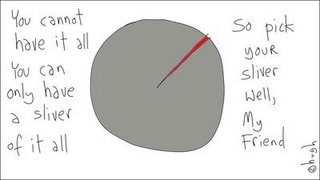
 You may have heard about this, and it is worth repeating. Architect Mike Pearce was given a complex challenge on a project in Zimbabwe. He was asked to build an office building that would be comfortable without air conditioning! The result: Eastgate, a mixed office comoplex and shopping mall covering half a city block in the business center of Harare, Zimbabwe. How did he do it? By studying termite mounds, which are able to maintain a constant temperature dispite ambient temperature swings ranging from 35 to 104 degrees. You can find out more about how it works at Wikipedia entry. Fascinating!
You may have heard about this, and it is worth repeating. Architect Mike Pearce was given a complex challenge on a project in Zimbabwe. He was asked to build an office building that would be comfortable without air conditioning! The result: Eastgate, a mixed office comoplex and shopping mall covering half a city block in the business center of Harare, Zimbabwe. How did he do it? By studying termite mounds, which are able to maintain a constant temperature dispite ambient temperature swings ranging from 35 to 104 degrees. You can find out more about how it works at Wikipedia entry. Fascinating!It is estimated that half the energy that we use in our homes is related to heating and cooling. So, what can we learn from the indiginous animals (insects being perhaps the most inventive of the bunch) that might help the frigid northeast stay warm, soggy northwest stay dry, the dry southwest stay cool, and all of the structures in our country work with nature instead of just against it? This could have huge economic and social consequences. How many social welfare dollars goes to paying utilities that could be used for other things? How many industries would be disrupted by this change of approach?
A lot has been said about looking to the animal kingdom for insight on how organizations function, how work is accomplished in teams, and for innovation insights for medicine, architecture, and energy production. A new term has been penned: biomimicry. I think this field is fascinating and makes practical sense. What other examples of biomimicry have you seen or heard about that have inspired you or your work?
It contracts how different companies (Dell, Quizno's sandwiches, P&G, etc) approach innovation, product planning, and market positioning. It poses some great questions about strategy, brand, hiring the best employees, and selling ideas to customers and executive management.
I'd love to hear your reactions.
The article is peppered with quotes from business leaders. Here are some of my favorites:
"It's a prerequisite that if you're going to fail, you have to fail forward." - Terry Hall, Chief Marketing Officer, Quizno's Sub
"I believe innovation comes from two sources: technology and the consumer. It's less about process and more about people - don't look at the numbers. Get out in the world." - Dan Buchner, vice president of innovation and design at Design Continuum, an industrial design firm.
In Dan's bio on the Continuum website, he claims to have received an MBA from the "School of Hard Knocks, University of Starting and Running your Own Manufacturing Firm." I love it!
I know I feel like I got an MBA from the "University of Building and Nurturing a Sales Channel" and another from the "University of Marketing Innovation" where my thesis was "never confuse activity with results." I think I am currently working on my Ph.D. in organizational psychology from the "University of Helping Others Embrace Change." What are you studying?
I had an illustration of this a few weeks ago. I had contacted the support group at 37Signals whose produce Basecamp I have used to manage a variety of projects for myself, my employer, and clients. I highly recommend this tool and I know they are always develping new offerings. I suggested to them that they develop a new interactive, collaborative scheduling service. The idea would be that it would allow a person to set up a calendar of events and allow people to RSVP. However, it would be more than an Evite (which is another tool I love and use all the time). The innovation that I was suggesting was that the tool would allow multiple events to be managed from one interface and that it would include an element of capacity planning. Let's say, a hair studio wanted to use a tool like this to accept online appointments. They could enter the number of stylists available throughout the day and the software would prevent people from overbooking, perhaps suggesting alternates that might work or managing a waiting list. I thought this would be cool for a variety of their small business customers and I knew that I could use it right away for a project I am working on for the Westside MOPS.
But, I digress. I sent the idea to them in some detail. I received a response back that surprised me. I thought that I would get a "thank you and we appreciate your ideas" email that would be that. Instead, I got a personal email back from Jason at 37Signals that read "We will not be building the software you suggested. We only build things we can use and we wouldn't use this."
Needless to say, I was a little taken back. I send them back an equally curt response saying how unfortunate it was that they would not be taking action on this and that I would have scheduled time to talk with them in more detail about the idea, but sadly they don't use scheduling software. But, the whole thing got me thinking.
Here is a company that is very well-respected and builds great tools. They got a suggestion for what would be a great product (in my humble opinion) and they said, "no." No, because it wasn't something they were passionate about. No, because, perhaps, it didn't fit into their vision of who uses their tools and why.
Although their response to me could have been a bit more respectful, I can see and appreciate their point. If they pour their resources into making Basecamp and other tools I use better, then I can't really complain.
So, my "collaborative scheduling" idea is out there. Somebody should develop this tool! If you know of any offerings like this on the market, I am very interested in learning about them. To learn of other product ideas or offerings that I have put on the curb to recycle, see Invention Recycling.
This approach has huge implications for marketing. While facts and figures can be captured on datasheets and product copy on a Website, solutions are hard to contain in these mechanisms. When emotions (ie, trust, confidence, safety) need to be communicated, it is best done through stories. Sometimes the story is about a product and other times it is about a company. Who, in your opinion, tells the best stories?
Stories are also critical within the organization, to build alignment and motivate stakeholders. More on that later.
Interestingly, I have been proud, as a customer, to have some of my suggestions integrated rapidly into products (I have seen it happen on LinkedIn and Basecamp by 37Signals). I can only assume I am not the only one asking for the enhancement that was implemented, but it does demonstrate to me that they care. From their perspective, however, they just received free market research to drive new development and built a little more loyalty with me in the process.
Several months ago they had a discussion about what "simple rules" would create sustainable innovation for companies which is a great example of the kind of topics that are featured. Here is a summary of a few of my favorites that kicked the discussion off.
A. Four Simple Rules
Contributor: Paul Hindes, president of Watcher Technologies as quoted
in Fortune Magazine's article "Making Decisions in Real Time"
(6/26/2000).
1. You can't be a jerk with clients.
2. Tell me if I have spinach in my teeth
3. Be responsive, but not dumb.
4. It's really, really okay to make mistakes.
Note: I have edited some of the potentially-offensive language from
the original, but I hope captured the essence (jd)
B. Everything I needed to learn, I learned in Junior High
Contributor: Unknown Junior High, as quoted in Margaret Wheatley's book
Finding Our Way: Leadership for an Uncertain Time (February 2005).
1. Take care of yourself.
2. Take care of each other.
3. Take care of this place.
C. Innovation and Progress
Contributor: Brian Barron as attributed to William Kingston's book Innovation: The Creative Impluse in Human Progress (1977).
1. Develop only the bare minimum to prove an idea
2. Prove only one idea at a time
3. Never develop what can be bought or modified
4. Minimize the time to demonstration
5. Insist on the highest standards of workmanship
6. Do all of this with the smallest team possible.
D. Google's 9 Rules
Contributor: Marissa Mayer (their innovation guru) 45-minute presentation on the Stanford University Website
1. Ideas come from everywhere
2. Cheer everything you can
3. You're brilliant, we're hiring
4. A license to pursue dreams
5. Innovation, not instant perfection
6. Data is apolitical
7. Creativity loves constraints
8. It's users, not money
9. Don't kill projects, morph them
If you could create a few "rules" (or guidelines or principles) that could create sustainable innovation within your company or organization, what would they be?
I love Zillow. This company out of Seattle was founded by a few Expedia alums that sought to provide better visibility to real estate pricing. The result is a website where you can map a property address and see the valuation of it and the surrounding properties. They literally provide an estimate (or a Zestimate, as they call it) for over 65 million homes. Essentially, this site is not only a fun interface, but is allows you to do your own real estate comparables and market research. They are adding metropolitan areas all the time and they claim a high accuracy rate. Check it out!
Another tool that is useful is one offered by a local real estate agent in Portland, Oregon powered by PDXHomeQuest and is now offered also in Seattle and San Diego. It is an email service that will provide you with the new listings in any price range or neighborhood that you specify, allowing you to keep tabs on MLS activity in your area. To sign up for the service in Portland, visit Donna Erickson's website.
Now these are useful tools and show the power of using data to create useful decision-driving information. I am always on the look-out for tools of this type.
In Patrick Lencioni's book The Five Temptations of a CEO (which is a great one, by the way), he warns business leaders to never confuse clarity with certainty. There are always things that are uncertain. Facts that require validation. Assumptions that need to be checked out. Assumptions that must be researched.
That uncertainty can't stop people from being clear in their communications. Better to say "here is what I know and here is what I don't know" and "here is what we are going to do," than say "I think we should do this." It is important in all of our communications that we model clarity, even if there are things about which we are uncertain. Better yet, if you feel like you can't be clear or certain in your communications, stop and take action immediately to resolve the issue. Once you find the answer or have taken appropriate action, then respond.
Note: sometimes this approach will require you to respond with a "I have heard you and will respond when I have a chance to give it proper attention". Especially if the request came via email, where people expect responses.
If you want to purchase a copy of Patrick's book--which is an easy, but insightful read-- click below.
The Five Temptations of a CEO: A Leadership Fable
The first is Plaxo. It is an online address book, essentially with a couple of twists. The first is that if I enter an address (triggered by a unique email address) of someone who is also a Plaxo user, we are "connected" and I am alerted to any updates or changes in their contact information. Second, I can send me own information (professional or personal or both) to selected contacts and have them update their own information. This is a useful way to make sure your address book has the latest information. I use the free online version, which requires nothing to be downloaded on my computer and alllows me to access it anywhere. The premium version has some features that are nice as well. I understand that some people do not like Plaxo's model and would rather use a more permission-based system, but for my work information which isn't so sensitive, I have Plaxo to be a useful tool.
The other tool that I enjoy using is LinkedIn. It is a social network that many of my professional contacts turned me onto. In essense, I can invite people to join my "network" and in return, they can access my network, allowing me to help them make introductions to others I know (and visa versa). The network affect takes hold, when you link these networks together by degreees of separation. My 200 (or so) contacts, actually connect me to nearly 7,000 people within 2 degrees of separation. Wild! I have used it to make contact into companies that I would have otherwise had to cold call. I use the free online version.
I'd encourage you to check these out. If you use either of these systems and know me personally, invite you to send me an invitation!









